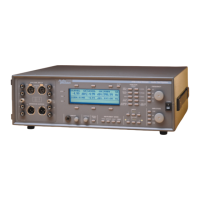In LEVEL function the filters, additional amplification, and selectable
detectors are excluded from the principal meter circuit so that both
meters become identical.
The secondary meter and reading detector have no selectable filters,
less gain than the primary meter (10 mV minimum signal for
fully-specified performance), and true RMS response only. The
measurement of the secondary reading detector is usually displayed in
the upper center section of the display. It generally shows the level of
the input signal before processing, and its reading may be used to
calculate some relative readings such as THD+N when % or dB units
are selected.
The AC MAINS function works by measuring the input line voltage
through very large resistors connected directly at the power mains
input connector.
The signal monitored by the loudspeaker or headphones is normally
picked off at the selected input channel, following input ranging but
preceding any filtering. An internal cable may be changed to move
the pickoff point to the end of the principal meter, following all filtering.
Digital Section
Figure 1-7 shows a simplified block diagram of the digital section of
the ATS-1 Dual Domain.
The heart of the digital section is the Motorola 56303 Digital Signal
Processor, or DSP. The DSP performs all calculations and controls all
other parts of the digital circuitry. It is controlled by the
microprocessor in the analog section. A special two-way
communication channel links the two microprocessors.
The digital generator signal originates in the DSP, which calculates the
waveform samples as required. The samples are sent to the AES/EBU
transmitter which formats them into the digital signal stream. The
transmitter drives the optical output directly, and the electrical outputs
through a variable-voltage driver. The electrical output is
transformer-coupled to the balanced (AES/EBU) and unbalanced
(SPDIF) outputs.
1 Description
Block Diagrams Description
1-12 ATS-1 Dual Domain User's Manual

